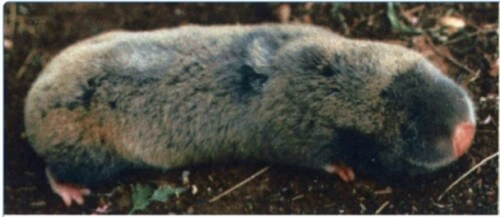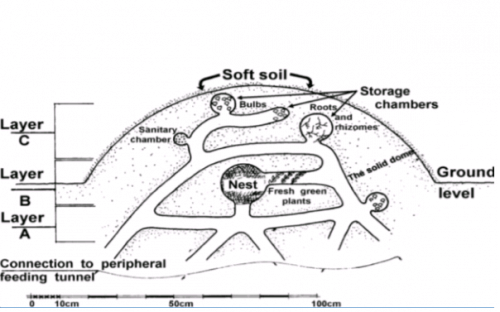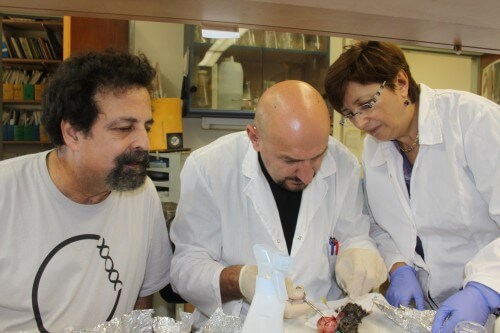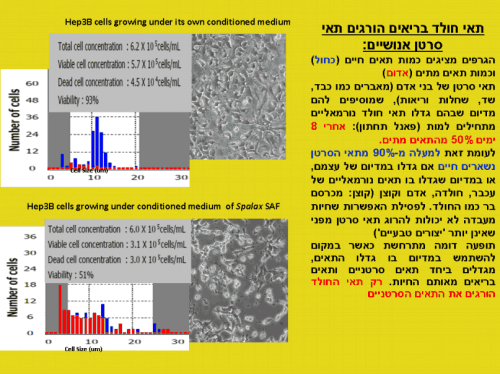A research team led by Prof. Aharon Avivi, Dr. Imad Shams and Dr. Irena Manov from the Institute of Evolution at the University of Haifa discovered that the blind Palestinian rat is immune to cancer and other "Western World" diseases such as heart disease and stroke. However, they have difficulty finding funding for further research because the foundations prefer to study mice * An article by the group was recently published in the journal BMC Biologt, explaining how healthy rat cells kill human cancer cells

A research team led by Research Prof. Aharon Avivi, in collaboration with his fellow researchers Dr. Imad Shams and Dr. Irena Manov from the Institute of Evolution at the University of Haifa, who are studying the blind Israeli rat, published this month (August 2013) in the BMC BIOLOGY newspaper a groundbreaking study in cancer research.
The rat is a rodent mammal that lives underground all its life, and is known to most of us only because of the mounds of earth that we see in the garden or on walks, especially after the rain, which are created from the soil that it pushes when it renews the underground canals that make up its 'home' (to give an impression of the power that this animal has , mainly in the neck muscle, it weighs 100-200 grams and the weight of each mound is about 3-4 kg. That means he can push up to 40 times his body weight!!!). This animal, closely related to the rat, is harmful to agriculture but a mystery to biomedical research. Since she lives underground, she has adapted, among other things, to life in a lack of oxygen (hypoxia, in our language). Hypoxia is a phenomenon directly related to those diseases that are 'killing the western world': heart disease, stroke, lung disease and above all cancer - the number one enemy of humanity. The rat does not suffer from any of them.
During the 40 years that the animal has been studied at the Institute of Evolution, thousands of animals have passed through the Institute's zoo (you cannot breed the rat in captivity. You have to catch it in the field), never was a cancerous tumor diagnosed in any of the animals. Not those that have just been caught in the wild, and not those that have lived in the zoo for 20 years or more. (The rat lives 5 times longer than a rat, and that in itself makes it an interesting model in an era where life expectancy is increasing, but not necessarily the quality of life.)

In recent years, research has been done to understand the cancer resistance of the Palestine rat, and of its distant relative, the naked rat. In these experiments, an attempt was made to examine the relationship between molecular mechanisms known to be associated with causing and developing or inhibiting cancer and the possibility of causing cancerous transformation of healthy cells from these two species of rats. However, none of them have been done on the animal itself, whole, when it is alive, nor has the interaction between normal, healthy, rat cells and human cancer cells been tested.
Research Prof. Aharon Avivi together with Dr. Imad Shams and Dr. Irena Manov tried to induce cancer in live rats, young and old (as we know, the older we get, the more vulnerable we are) using carcinogenic substances. These caused the expected growth in 100% of mice and rats, but did not induce cancer in rats. That is, not only is the rat exceptionally resistant to a spontaneous outbreak of cancer, it is also very difficult to induce cancerous tumors in it. And the icing on the cake in this study: it was found that cells from a rat, and only from a rat and not from other species, inhibit cancer growth and ultimately kill cancer cells that are found in various animals, both laboratory animals and rodents from nature, as well as humans; Cancerous tumors that are found in different tissues, including a violent and metastatic type of breast cancer. This ability is unique to cancer cells. And they do not harm healthy cells. These findings amount to a scientific 'earthquake'.
According to Prof. Avivi, the research is original and pioneering. Leading scientists in cancer research were impressed by it and predict that it has a real potential for a breakthrough in cancer research for human well-being (Prof. Schlesinger, School of Medicine, Yale University, USA; Prof. Volodevsky, School of Medicine, Technion, Haifa; Prof. Robert Weinberg, MIT, USA; Prof. Ofer Lavi, Head of the Department of Oncology, Carmel Medical Center, Haifa)

Cancer research has been done since its inception on mice. A great deal has been learned about the incubating of cancer, its development and inhibition from research on mice. It would be reckless to dismiss the mouse and what was learned from it out of hand, but, for years the great cancer researchers who worked on mice and laid the foundations for cancer research, claim that it failed as a model in the main problem - it did not advance the cure of the disease in humans. Cancer researchers are convinced that what is missing for progress in curing cancer in humans is a suitable model animal: "It is impossible to predict what will happen in humans from studies done on mice. It is the lack of a suitable animal model that is holding back progress towards finding a cure for cancer in humans (Prof. Robert Weinberg, MIT and others)".
It seems that the rat is the animal that the researchers are looking for, and that will advance solutions to cure cancer in humans. A defense mechanism developed over tens of millions of years of evolution is the key to solving the disease. That is why it is of great importance to study the rat.
However, between the cancer researchers and the foundations that provide research grants, as well as the editors of professional journals in the life sciences, there is a chasm. These are still captives in the conservative paradigm of the 'mouse', and reject research grants and scientific publications that use model animals other than the "classical animal", because "every question surely has an answer that can be sought and found in a well-established model animal (ie - a mouse).
This phenomenon is known in the world of life sciences and is subject to severe criticism (See for example in Nature).
As a result of this policy, Prof. Avivi's research group is at a dead end. Regarding "the land you will see and you will not come to it". Therefore, beyond the interest in presenting the research to the general public, the purpose of this publication is to arouse interest among donors, philanthropists, those with the right heart and a generous hand so that they will positively consider helping them finance at least the next stage of the research: the Sisyphean work, gray and inglorious, but very expensive, and it is To find the "needle in the haystack": isolate, characterize and purify the substance/s that only the rat cells secrete and which kill only cancer cells, but not healthy cells; find which substance(s) in cancer cells they interact with; to define the molecular-biochemical pathway of this interaction, in an attempt to reach a clinical test. The researchers believe that when they succeed in doing this, it could be an extraordinary and impressive breakthrough in trying to cure cancer in humans in the early stages of its development.

א

11 תגובות
On the face of it, it seems that the conditions in which the rat lives cause the same diseases that were mentioned, and if indeed the rat's body is resistant to them, it is likely that those two types of rat went through an effective evolutionary process, during which only resistant individuals remained.
Skeptic, you're a blabbermouth. Why don't you read the article: it says that they worked on young and old rats. Maybe try reading the article. Is a rat a laboratory animal? How do you conclude that laboratory animals do not suffer from cancer? On the contrary, since so-and-so will die from cancer even without any experiment, this is the first reason they used them. Because it's easy to soak crops in them... and after that try to learn about them... and after that find out that they learned a lot only it's not equal to humans.
Anonymous user, you talk such nonsense that it is simply impossible to treat them in a structured way at all, so it is a waste of energy to try to explain to you how ignorant you are.
60% percent of large dogs that live to the age of 15 get cancer
Whereas only a few percent of people get cancer by the age of 15
What it means: nothing
A different genetic system with more emphasis on variation and less on cancer and longevity in dogs
We won't have the possibility in 20 years to transfer the lifespan of humans to dogs.
kadur
correct question The wording is probably misleading.
It must be assumed that the aforementioned rat also died from vascular diseases like all animals, but not from seizures (sudden events) but from gradual processes (such as ischemic heart disease, tiny strokes in the brain, etc.).
about cancer It is possible that this is a resistance to cancer at a young age of the rat. It is likely that as the rat ages, its resistance to cancer decreases and it will also die from cancer, like most or all animals. Animals for laboratory experiments are probably mostly young, so I wouldn't conclude that they don't get cancer in their old age.
I know this is a dumb question, but if the rat doesn't die of cancer, a stroke, and a heart attack, how exactly does it end its life?
Turtle, the article in NATURE as well as Gorbonova's previous articles, in PNAS, are as perforated as Swiss cheese and full of internal contradictions that it is not clear how no one has overcome them. How her articles were accepted into PNAS is clear: a member of the Academy of Sciences, an old man, a retiree of the Institute of Evolution whom no one is willing to cooperate with, because he lacks morals and a dictator, who was elected to the Academy in a political process, who is used as a 'mole' and a fifth brother-in-law to his colleagues at the Institute of Evolution, put them in to the newspaper as part of the absolute trust that the newspaper has in the members of the academy, who are in fact freed from any judgment and review procedure that applies to those who are not such and try to submit an article to PNAS. People like him cause the value of the newspaper, its influence among the world's scientists to continuously deteriorate for several years. Regarding the article in NATURE, everyone who investigates in the field is surprised how Gorboneva managed to push her barbarian pile there.
I don't know if you've read the article by this group, it seems that you haven't even read the article here (at least carefully) - but you should at least read the discussion. There is a broad and thorough reference to Gurbanova's articles.
Turtle, you are probably not just 'out of the field', you have serious, basic problems with reading or understanding it.
The icing on the cake in this study: it was found that cells from a rat, and only from a rat and not from other species, inhibit cancer growth and ultimately kill cancer cells found in various animals, both laboratory animals and rodents from nature, and also humans; Cancerous tumors that are found in different tissues, including a violent and metastatic type of breast cancer. This ability is unique to cancer cells. And they do not harm healthy cells.
Oh, about two months ago a beautiful article was published in Nature (also a cover) about a mechanism involved in the blind rat's resistance to cancer.
These data are meaningless as long as the appropriate review does not appear next to them. In this case at least a comparison to the effect of rat cells on non-cancerous human cells. It may be that more reviews are required, but it is difficult for me, as someone outside the field, to specify them.
Kudos to the researchers
Successfully !!!! You're on to something, it makes an impression